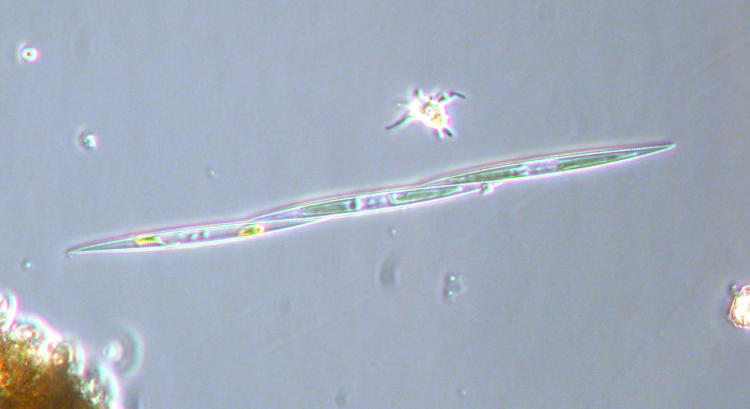
Phytoplankton, the microscopic algae that live in marine waters and drift with ocean currents, are a key component of the marine ecosystem. These primary producers at the base of the food web create the food directly consumed by many marine animals. The productivity of the marine waters off of the Oregon coast, like that of all ocean waters, is closely tied to this primary production of food from sunlight, water, carbon dioxide and nutrients by phytoplankton. Filter feeding bivalve shellfish such as clams, mussels, scallops and oysters extract and ingest these algae along with small drifting animals, called zooplankton, as they pump water through their bodies to feed and respire. Similarly, many forage fish species such as northern anchovy, Pacific herring and Pacific sardine feed on both phytoplankton and zooplankton.
However some types of phytoplanktonic algae produce biotoxins that accumulate in animals that eat them causing illness and death in seabirds and mammals higher up the food web. Other types of these algae produce surfactant-like proteins that create foam on the water’s surface. Seabirds exposed to the foam lose the waterproof coating on their feathers which keeps them dry resulting in death from hypothermia or a restricted ability to fly. Problems occur when there are blooms of these types of algae. These harmful algal blooms (HABs) cause losses of natural resources, economic losses to coastal communities, and have resulted in human illnesses and deaths. Although these blooms largely occur in the open water habitats off our coast the effects of HABs are often most acutely felt along the shorelines.
The most direct effects on people along the west coast of the U.S. result from biotoxins produced in two types of HABs. Blooms of dinoflagellates in the genus Alexandrium produce saxitoxin, a neurotoxin that causes paralytic shellfish poisoning in humans. Blooms of diatoms in the genus Pseudo-nitzchia produce domoic acid that causes amnesic shellfish poisoning in humans. Paralytic shellfish poisoning cases were first recorded on the west coast of North America in 1793, when members of Captain George Vancouver’s crew became sick after eating a breakfast of mussels collected from the shores of what is now British Columbia, Canada. Paralytic shellfish poisoning can cause death from respiratory failure due to paralysis. Amnesic shellfish poisoning causes gastrointestinal and neurological disorders in humans and can be life-threatening. Pseudo-nitzchia is known to have been present off the west coast since at least the 1920s, but the first documented outbreak of problems related to poisoning from domoic acid on the U.S. west coast occurred in 1991 with a die off of sea birds in California and contamination of razor clams and Dungeness crabs in Washington, Oregon and California. Although never confirmed, 25 cases of amnesiac shellfish poisoning were suspected in Washington during the 1991event.
Monitoring for these HABs and sampling shellfish for food safety have resulted in closures or opening delays for both recreational and commercial shellfish fisheries in Oregon as well as in Washington and California over the years. Fisheries for razor clams, California mussels, Dungeness crab, northern anchovy and several other species have been affected. These closures have had economic consequences for coastal communities, but are necessary for public safety. Monitoring efforts can be conducted at two levels: sampling waters to monitor the phytoplankton for HABs and sampling organisms that consume phytoplankton to monitor for the accumulation of the disease causing toxins. The Oregon Department of Agriculture currently monitors several species of shellfish for accumulation of biotoxins. From 2005 to 2012, ODFW in collaborations with OSU, UO and the NOAA Northwest Fisheries Science Center utilized funds from a federal to develop an integrated HAB monitoring and event response program. For ODFW, this resulted in monitoring phytoplankton directly at ten sites along the Oregon coast which provided ODA with an early warning system about potential HAB events. This work also stimulated collaborative research leading to insights into the occurrence of HABs off our coast. Oregon has not directly sampled its coastal waters for HABs since 2012 due to a lack of ongoing funding to do so. To assure human safety, monitoring of selected bivalve shellfish species for biotoxins by ODA continues in Oregon and has expanded in scope to include Dungeness crab for the foreseeable future due to events in 2015 and early 2016. Information about recreational harvest closures for shellfish can be found on the ODA website.
While HABs are often localized events, research suggests that the frequency and spatial extent of HABs off the west coast has increased over the last several decades. A geographically extensive and long lasting bloom of Pseudo-nitzchia that affected marine wildlife and fisheries along the west coast began in the spring of 2015. The bloom stretched from Alaska to California and persisted far longer than what is considered normal. Scientists called this an unprecedented event. Some west coast fisheries remained closed through May of 2016. NOAA‘s Northwest Fisheries Science Center provides an excellent overview and more information on HABs.